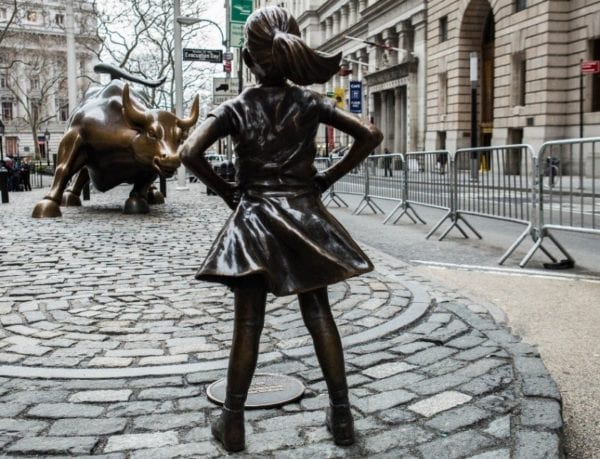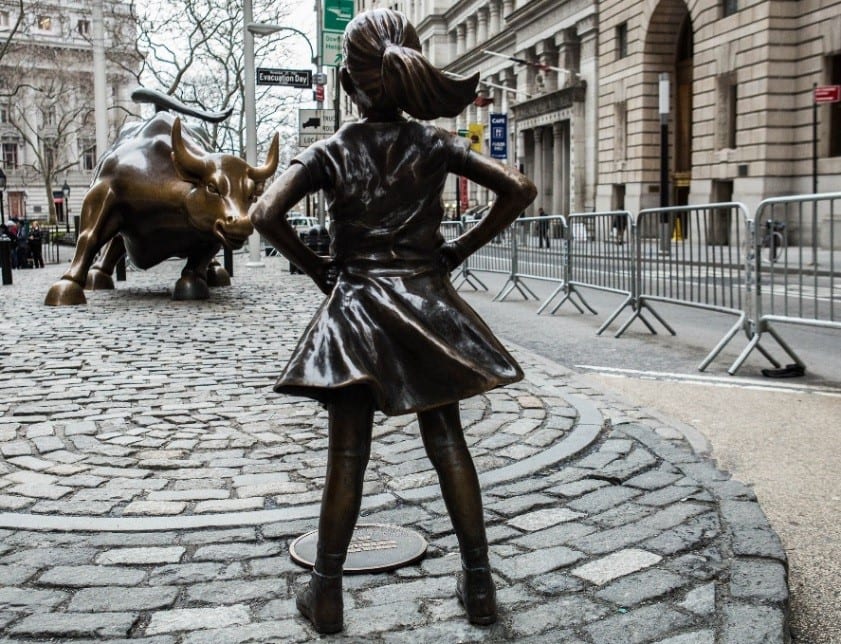
In the wake of the global stock market crash of 1987, the Sicilian immigrant Arturo Di Modica created the guerilla artwork known as Charging Bull. Without permission, and after spending $350,000 of his own funds, Di Modica had the bull installed in 1989 near Wall Street in New York City during the height of Christmas season to symbolize the strength and power of the American people. Many tourists and locals alike loved the Charging Bull and identified it as “the only significant work of guerrilla capitalist art in existence.” The New York Stock Exchange quickly removed the 3.5-ton statue the day it was installed, but the resulting public outcry led to its “temporary installation” in a nearby location; thirty years later, Charging Bull is still standing strong as one of the most iconic symbols of New York City. On March 7, 2017, Charging Bull was faced with a new opponent.

During the night before International Women’s Day in March 2017, a small sculpture of a young girl was quietly placed in front of Charging Bull. Known as Fearless Girl, the unscheduled installation stands defiantly with her hands on her hips and faces the bull with an unwavering confidence. At the feet of the statue was a bronze plaque that reads “Know the power of women in leadership. SHE makes a difference.” The initial reaction from many people was that this was another act of guerrilla art, one particularly needed now given Wall Street’s challenges with gender equity and diversity. The work’s sculptor, Kristen Visbal, further enabled such a reading explaining her work: “She’s not angry at the bull, she’s confident, she knows what she’s capable of and she’s wanting the bull to take note.” But looks can be deceiving. State Street Global Advisors, a prominent financial firm which oversees $2.5 trillion in assets, invested in Fearless Girl to promote their “Gender Diversity Index,” a fund that “invests in U.S. large-capitalization companies that rank among the highest in their sector in achieving gender diversity across senior leadership.” The use of “SHE” in the inspirational plaque quotation may be meant as a gender pronoun, but in its capitalized form it is also the NASDAQ ticker symbol for the promoted State Street Global Advisors fund. A Bloomberg report indicated that the statue generated an estimated $7.4 million in free marketing for the investment firm in the first two months after the statue’s installation.
Arturo Di Modica was not consulted about the placement of Fearless Girl, and he did not share the same excitement of those who saw the installation of Fearless Girl as an amazing addition to the territory occupied by his Charging Bull. Di Modica demanded that Fearless Girl be removed and placed elsewhere because it takes away the power of his work, largely by reframing its meaning. His inspirational bull ceased to be the protagonist of the Wall Street story, and quickly became the antagonist in a larger drama—a representation of the Wall Street orthodoxy that is accused of holding women back from true equality in the world of business. The city removed Fearless Girl, but she was quickly placed back in front of the bull due to the resulting public uproar. Di Modica is still outraged and wants Fearless Girl gone. He claims that his bull is “for art,” while Fearless Girl is a manipulative marketing scheme orchestrated by a big firm. Other critics joined him in denouncing Fearless Girl as an act of “corporate feminism,” a “marketing coup,” and an advertising trick.
The controversy centers on how art communicates and when reframing existing art is unethical or wrong. Fearless Girl would lose its meaning and importance without Charging Bull; she would simply be a confident little girl, and not a statement about Wall Street’s gender problems. Di Modica argues that Fearless Girl harms the meaning of his artwork: by reframing or re-appropriating the meaning of Charging Bull through the addition of another statue, Di Modica’s work now seems tied to a meaning and significance he did not intend. Di Modica still owns Charging Bull and can move it if he so desires, but he has so far advocated for the removal of the more recently added statue that reframes his original work.
Those who side with the creators of Fearless Girl believe that it is a valid instance of appropriation or re-appropriation in art, often a rich practice of reframing existing art or symbols in order for ostracized social and cultural groups to challenge the traditional social order or powerful organizations. When seen as a reaction to the iconic artistic symbol of Wall Street, the message Fearless Girl depicts to many viewers the message that women are extremely powerful, uplifting, and encouraging. While Di Modica was fighting to have the statue removed, New York Mayor Bill de Blasio joined the dispute, tweeting that “Men who don’t like women taking up space are exactly why we need the Fearless Girl.” Standing confident, unafraid and unwilling to back down, Fearless Girl’s impact would not be as affective without Charging Bull. According to de Blasio, Fearless Girl asserts that “women were not going to live in fear, that women were going to teach their daughters and all the women in their lives to believe in themselves.” The company who backed Fearless Girl explains that they wanted to “raise awareness and drive a conversation around the need to improve gender diversity in corporate leadership roles.” They clearly succeeded to do so by using Fearless Girl to reframe the meaning of Charging Bull—but did their fearless pursuit of gender equality go too far?
Discussion Questions:
- Was Charging Bull’s meaning changed by the addition of Fearless Girl? Was the original work—or its artist—harmed in any way?
- Should Fearless Girl be placed elsewhere? Should she stay? If you advocate moving her to another location, would you insist on moving Charging Bull as well?
- Is it ethical for the creator of Fearless Girl to use another artist’s work as part of her own message or artwork? What if incorporating, reframing, or visibly critiquing a previous work was the only way to express the point an artist wanted to make?
- What ethical limits would you place on artists wanting to reframe the artworks produced by previous artists?
- Do the details concerning the artists and their funders matter to judgments about the aesthetic merits of each of these work? If these details changed, would your conclusions about the ethical and aesthetic worth of Fearless Girl change?
Further Information:
Bill Eggbert, “Bullshift! City may try to move Charging Bull statue.” Downtown Express, March 1, 2018. Available at: http://www.downtownexpress.com/2018 /03/01/bullshift-city-may-try-to-move-charging-bull-statue/
Greg Fallis, “Seriously, the guy has a point.” April 14, 2017. Available at: https://gregfallis.com/2017/04/14/seriously-the-guy-has-a-point/
Lawrence Husick, “Ask Dr. Copyright about Fearless Girl and copyright appropriation.” May 5, 2017. Available at: http://garson-law.com/ask-dr-copyright-about-fearless-girl-and-copyright-appropriation/
Jill Mavro, “Driving gender diversity with a bold new statement.” March 7, 2017. Available at: http://blog.spdrs.com/post/driving-gender-diversity-with-a-bold-new-statement
Liam Stack, “‘Fearless Girl’ statue to stay in financial district (for now).” New York Times, March 27, 2017. Available at: https://www.nytimes.com/2017/03/27/nyregion/fearless-girl-statue-de-blasio.html
Authors:
Morgan Malouf & Scott R. Stroud, Ph.D.
Media Ethics Initiative
University of Texas at Austin
March 10, 2018
Cases produced by the Media Ethics Initiative remain the intellectual property of the Media Ethics Initiative and the University of Texas at Austin. They can be used in unmodified PDF form without permission for classroom use. For use in publications such as textbooks, readers, and other works, please contact the Media Ethics Initiative.



